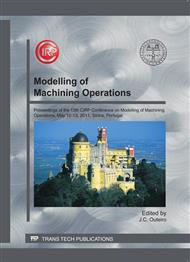[1]
C.Y. Huang and J.J. Wang: Mechanistic Modeling of Process Damping in Peripheral Milling (Transactions of the ASME, Journal of Manufacturing Science and Engineering, Vol. 129, Feb. 2007, pp.12-20).
DOI: 10.1115/1.2335857
Google Scholar
[2]
D.Y. Jang and A. Seireg: Tool Natural Frequency as the Control Parameter for Surface Roughness (Machine Vibration, Vol. 1, 1992, pp.147-154).
Google Scholar
[3]
J. Tlusty: Dynamics of high speed milling (Transactions of the ASME, Journal of Engineering for Industry, Vol. 108, 1986, pp.59-67).
Google Scholar
[4]
J. Tlusty and F. Ismail: Special Aspects of Chatter in Milling (Transactions of the ASME, Journal of Engineering for Industry, Vol. 105, 1983, pp.24-32).
Google Scholar
[5]
D. Montgomery and Y. Altintas: Mechanism of cutting force and surface generation in dynamic milling (Transactions of the ASME, Vol. 113, 1991, pp.160-168).
DOI: 10.1115/1.2899673
Google Scholar
[6]
K. Mehdi, J.F. Rigal and D. Play: Dynamic Behavior of a thin wall cylindrical WorkPiece During the Turning Process Part I: Cutting Process Simulation (Journal of Manufacturing Science and Engineering, Vol. 124, Issue 3, 2002, pp.562-568).
DOI: 10.1115/1.1431260
Google Scholar
[7]
K. Mehdi, J.F. Rigal and D. Play: Dynamic Behavior of a thin wall cylindrical WorkPiece During the Turning Process Part II: Experimental approach and validation (Journal of Manufacturing Science and Engineering, Vol. 124, Issue 3, 2002, pp.569-580).
DOI: 10.1115/1.1432667
Google Scholar
[8]
K. Mehdi and J.F. Rigal: A Numerical Model for Cutting Process Simulation and Prediction of Cutting Forces in Peripheral Milling (Proceedings of the IEEE International Conference on Industrial Technology, Vol. 2, 2004, pp.734-740)
DOI: 10.1109/icit.2004.1490166
Google Scholar
[9]
K. Mehdi , T. Mezni and J.F. Rigal: Modeling the effect of cutting and tool parameters on the dynamic behavior of a thin walled workpiece in peripheral milling process (Journal of Machining and Forming Technologies, ISSN: 1947-4369, Vol. 1 Issue 1/2, 2009, p.35 – 50)
Google Scholar
[10]
S. Jain and D.C.H. Yang: A systematic force analysis of the milling operation (Transactions of the ASME, Journal of Engineering for Industry, Vol. 40, 1989, pp.55-63).
Google Scholar
[11]
J.J. Wang, and C.M. Zheng: An Analytical Force Model with Shearing and ploughing Mechanism for End Milling (International Journal of Machine Tools Manufacture, Vol. 42, 2002, pp.761-533).
DOI: 10.1016/s0890-6955(02)00019-6
Google Scholar
[12]
X.W. Liu, K. Cheng, D. Webb and X.C. Luo: Prediction of cutting force distribution and its influence on dimensional accuracy in peripheral milling (International Journal of Machine Tools and Manufacture, Vol. 42, 2002, pp.791-800).
DOI: 10.1016/s0890-6955(02)00016-0
Google Scholar
[13]
R.P.H. Faassen, N. van de Wouw, J.A.J. Oosterling and H. Nijmeijer: Prediction of regenerative chatter by modeling and analysis of high –speed milling (International Journal of Machine Tools and Manufacture, Vol. 43, 2003, pp.1437-1446)
DOI: 10.1016/s0890-6955(03)00171-8
Google Scholar
[14]
T.R. Sission and R.L. Kegg: An Explanation of Low Speed Chatter Effects (ASME Journal of Engineering for Industry, Vol. 91, N° 4, 1969, pp.951-958).
DOI: 10.1115/1.3591778
Google Scholar
[15]
D. W. Wu: A New Approach of Formulating the Transfer Function for Dynamic Cutting Processes (ASME, Journal of Engineering for Industry, Vol. 111, 1989, pp.37-47).
DOI: 10.1115/1.3188730
Google Scholar
[16]
K. Nakayama and M. Arai: On the Storage of Data on Metal Cutting Forces (Annals of CIRP, Vol. 25, 1976, pp.13-18.)
Google Scholar
[17]
D.W. Wu and Y. Matsumoto: The effect of Hardness on Residual Stress in Orthogonal Machining of AISI 4340 Steel (Transactions of the ASME, Journal of Engineering for Industry, Vol. 112, 1990, pp.245-252).
DOI: 10.1115/1.2899582
Google Scholar


